View in other NatureServe Network Field Guides
NatureServe
Montana
Utah
Wyoming
Idaho
Wisconsin
British Columbia
South Carolina
Yukon
California
New York
Flowering-rush - Butomus umbellatus
Other Names:
Flowering Rush
State Rank Reason (see State Rank above)
Flowering Rush was first collected in Montana along the north margin of Flathead Lake in 1962. It is now occurs in Sanders, Lake, and Flathead Counties, and in Flathead Lake, upper and lower Flathead Rivers, Clark Fork River into Lake Pend Oreille (Idaho), Thompson Falls Reservoir, Noxon Reservoir, and Cabinet Gorge Reservoir. A conservation status rank is not applicable (SNA) because exotic plants are not a suitable target for conservation activities.
General Description
PLANTS: A rhizomatous perennial that grows as emergent or submergent plants, and resemble a large sedge (Parkinson et al. 2010). As an emergent plant with upright foliage, they grow from shoreline to shallower waters (0 to 3 meters [10 feet]). As a submergent plant with flexible foliage, they grow in deeper waters from 3 to 6.1 meters (10-20 feet). Their rhizomes are fleshy with white knobs (vegetative bulbils) that produce leaves.
LEAVES: Leaves mainly basal, 2-ranked, ascending to erect, linear, 4–8 mm wide (Lesica 2012). The blade transitions from being triangular in its lower portion to being flat in its upper portion, which causes the leaf to twist (FNA 2000; Parkinson et al. 2010).
INFLORESCENCE: An umbel enclosed by 3 ovate, purplish bracts, reflexed at anthesis (Lesica 2012). The pedicels are unequal, 1–9 cm long (Lesica 2012). The scape grows 50–100 cm long, and overtops the leaves (Lesica 2012).
Phenology
Rhizomes begin to grow in February to mid-April. Flowering occurs from early summer to mid-fall.
Diagnostic Characteristics
A robust plant with leaves that resemble a sedge and flowers that do not (Parkinson et al. 2010). Leaves of emergent plants are triangular becoming flat towards their tips, making them twist. They are also spongy and compressible. The developing inflorescence (umbel) is enclosed by 3 large, purplish bracts that reflect backwards. Flowers occur in groups of 20-50 that display like an umbrella at maturity. Each flower consists of 3 sepals, 3 petals, and 9 stamens. Rhizomes are present and very fleshy.
Species Range
Montana Range
Range Descriptions
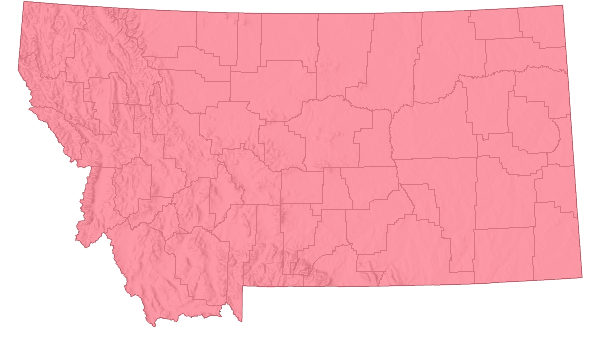
 Non-native
Non-native
Range Comments
Native to Eurasia and now introduced through most of the northern U.S. and southern Canada (FNA 2000). It was first collected in North America near La Prairie, Quebec on the St. Lawrence River in 1905, though its presence was known prior to this (FNA 2000). It is considered naturalized near Detroit, Michigan and St. Lawrence River areas (FNA 2000). It was intentionally introduced in North America for use in water-gardens (Parkinson et al. 2011).
For maps and other distributional information on non-native species see:
Nonindigenous Aquatic Species Database from the U.S. Geological Survey
Invasive Species Habitat Tool (INHABIT) from the U.S. Geological Survey
Invasive Species Compendium from the Centre for Agriculture and Bioscience International (CABI)
EDDMapS Species Information EDDMapS Species Information
Observations in Montana Natural Heritage Program Database
Number of Observations: 330
(Click on the following maps and charts to see full sized version)
Map Help and Descriptions
Relative Density
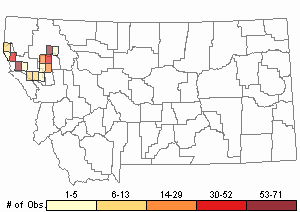
Recency
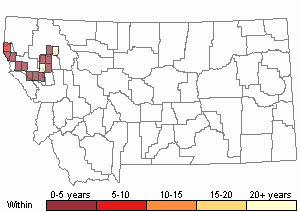
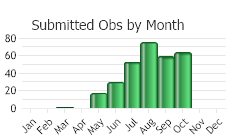

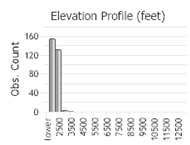 (Observations spanning multiple months or years are excluded from time charts)
(Observations spanning multiple months or years are excluded from time charts)
Habitat
Marshes, wetlands, irrigation ditches, and slow-moving water along riverbanks (Parkinson et al. 2010; Lesica 2012). It grows from the shoreline to water depths of 20 feet (6.1 meters). At depths greater than 10 feet (3 meters), submersed leaves become limp and more ribbon-like (Parkinson et al. 2011). Drawdown zones where water recedes to expose soil are very susceptible to colonization by Flowering Rush.
Ecology
Rhizome fragments are buoyant and filled with large reserves of carbohydrates which facilitate survival and long-distance dispersal (Parkinson et al. 2011). Rhizomes can establish in shallow, sparsely vegetated or unvegetated silty substrates where water flow is less than two miles per hour.
Plants are less likely to establish in water bodies with stable water levels (Parkinson et al. 2011). Further Flowering Rush was observed to not penetrate reed patches growing in stable water (Parkinson et al. 2011).
Flowering Rush plants have easily colonized drawdown zones in the Pacific Northwest (Parkinson et al. 2011). Rhizome sprouting and growth is accelerated by receding water that exposes unvegetated or sparsely vegetated soils that also warm quickly (Parkinson et al. 2011). Habitats in Montana that naturally drawdown usually exhibit cycles of inundation in the winter and spring followed by a gradual evaporation of water through the summer. In these habitats, native plants germinate and grow as water recedes. Dams have altered this hydrological cycle, such that reservoirs and lakes are held at full pool during the summer and by late winter and early spring are at low pool. These areas promote the establishment and growth of Flowering Rush because exposed late winter to early spring soils are moist with little to no competition from native vegetation (Parkinson et al. 2011). Irrigation canals exhibit a similar hydrology and are susceptible to invasion by Flowering Rush.
As an exotic plant, Flowering Rush lacks controls that can limit its population. Prolific growth occurs in irrigation canals that flow during the summer and cease by early winter. Flowering Rush densely colonizes the bottoms and sides of irrigation ditches, impeding the distribution of water and increasing the magnitude of maintenance. In lakes, dense patches interfere with boat propellers, swimming, and fishing (Parkinson et al. 2011).
Flowering Rush can change the ecology of ponds and lakes (Parkinson et al. 2011). It creates habitat favorable for the Great Pond Snail that hosts parasites that cause swimmer’s itch (Parkinson et al. 2011). It can negatively impact native fish species when unvegetated or sparsely vegetated water is colonized by dense stands of Flowering Rush. In Montana Bull Trout and Cutthroat Trout use open water habitats while introduced fish like Largemouth Bass, Yellow Perch, and Northern Pike prefer vegetated substrates for spawning (Parkinson et al. 2011). The upright foliage of Flowering Rush provides cover for predatory fish like the Northern Pike. In the Flathead River the Northern Pike has significantly depredated Cutthroat Trout and Bull Trout, impairing the recovery of these native fish (Parkinson et al. 2011).
Reproductive Characteristics
Flowering scapes produce 20-50 flowers (Parkinson et al. 2010). Flowers are perfect, regular with 3 green sepals and 3 pinkish petals (8–12 mm long) (Lesica 2012). Flowers have 9 stamens, a superior ovary, and 6 pistils. The fruit is a beaked follicle, 8–10 mm long, with many (200!) seeds (Parkinson et al. 2010; Lesica 2012).
A flowering mudflat form and a non-flowering submersed form of B. umbellatus have been recognized, but are not given taxonomic systematic status in the Flora of North America (FNA 2000). The flowering type reproduces by its fertile seeds, vegetative bulbils on the rhizomes, vegetative bulbils on the flowers, and fragmentation of the rhizomes (Parkinson et al. 2010). Populations in Montana represent the non-flowering type, which does occasionally flower but produces sterile seeds (Parkinson et al. 2010). This sterile type does reproduce well by its rhizomes and fragmentation of the rhizomes (Parkinson et al. 2010). Rhizomes easily detach because of a constriction that develops where the bud attaches to the rhizome. Rhizomes break apart from wave action, currents, moving boats, and waterfowl. The rhizomes float making for easy long-distance dispersal (Parkinson et al. 2010).
LIFE CYCLE (adapted from Parkinson et al. 2010)
Rhizomes initiate growth in the late winter to early spring before native aquatic plants grow. Growth continues through the growing season with flowering occurring from early summer to mid-fall. Frost causes the leaves to collapse and dieback.
Management
Flowering-rush has been a listed noxious weed in Montana since at least 2015. Its spread from one water body to another has primarily occurred through fragmented rhizomes in river and irrigation systems.
PREVENTION (adapted from Parkinson et al. 2010)
* Thoroughly rinse any mud and debris from all equipment and wading gear, and drain the water from the boat before leaving access areas. Use boat-washing stations when available.
* Remove all plant fragments from the boat, propeller, and boat trailer
* Dry boats and equipment for 5 days before transporting them to a new water body.
* Do not dispose aquarium water or plants into water bodies.
* Desiccate plant material and/or dispose by securely sealing in plastic bags and placing in the trash for disposal.
* Learn to identify Flowering Rush and report your findings to the Montana Department of Agriculture; Montana Fish, Wildlife and Parks; County Extension agent; or Weed Coordinator.
CHEMICAL CONTROL (adapted from Parkinson et al. 2010)
Researchers at the University of Montana and Salish Kootenai College are investigated the use of herbicides for Flowering Rush control. Consult your County Extension Agent and/or Weed District for more information.
MECHANICAL CONTROL (adapted from Parkinson et al. 2010)
Hand-digging to remove all root fragments may be feasible for small infestations, especially when water levels are low. Properly installed and maintained bottom barriers may be effective at restricting the spread of Flowering Rush, particularly at boat moorings. Mechanical control that disturbs the bed of a lake or river or bottom barriers may require permits from state or tribal agencies. Any mechanical control that disturbs the root system without completely removing it is not recommended. Raking is not recommended as it will fragment the root. Cutting Flowering Rush below the water surface will temporarily reduce abundance, but repeated cuttings are required and all plant materials must be removed and desiccated before disposing or else the plant may spread.
CULTURAL CONTROL (adapted from Parkinson et al. 2010)
Flowering Rush quickly invades areas lacking native aquatic plants and slowly invades areas with existing vegetation. Management that encourages the growth and viability of native aquatic vegetation is recommended to reduce the risk of spread by Flowering Rush.
To avoid accidentally introducing non-native plants to surrounding water bodies, never place your water-garden near or allow water to overflow into wetlands, streams, rivers, lakes, or ponds. Non-native water-garden plants should never be dumped into natural water bodies. Before purchasing plants, verify that the plant is not invasive, particurly for Montana.
Contact information for Aquatic Invasive Species personnel:Montana Fish, Wildlife, and Parks Aquatic Invasive Species staffMontana Department of Natural Resources and Conservation's Aquatic Invasive Species Grant ProgramMontana Invasive Species Council (MISC)Upper Columbia Conservation Commission (UC3)Stewardship Responsibility
References
- Literature Cited AboveLegend:
 View Online Publication
View Online Publication Flora of North America Editorial Committee (FNA). 2000. Flora of North America north of Mexico. Vol. 22. Magnoliophyta: Alismatidae, Arecidae, Commelinidae (in part), and Zingiberidae. Oxford Univ. Press, New York. xxiii + 352 pp.
Flora of North America Editorial Committee (FNA). 2000. Flora of North America north of Mexico. Vol. 22. Magnoliophyta: Alismatidae, Arecidae, Commelinidae (in part), and Zingiberidae. Oxford Univ. Press, New York. xxiii + 352 pp. Lesica, P., M.T. Lavin, and P.F. Stickney. 2012. Manual of Montana Vascular Plants. Fort Worth, TX: BRIT Press. viii + 771 p.
Lesica, P., M.T. Lavin, and P.F. Stickney. 2012. Manual of Montana Vascular Plants. Fort Worth, TX: BRIT Press. viii + 771 p. Montana Department of Agriculture (MDA). 2017. Montana Noxious Weed List. February. Helena, Montana.
Montana Department of Agriculture (MDA). 2017. Montana Noxious Weed List. February. Helena, Montana. Parkinson, H., J. Mangold, V. Dupuis, and P. Rice. 2010. Biology, ecology and management of flowering rush (Butomus umbellatus). EB0201. December. Montana State University Extension, Bozeman, Montana.
Parkinson, H., J. Mangold, V. Dupuis, and P. Rice. 2010. Biology, ecology and management of flowering rush (Butomus umbellatus). EB0201. December. Montana State University Extension, Bozeman, Montana.
- Additional ReferencesLegend:
 View Online Publication
View Online Publication
Do you know of a citation we're missing? Lesica, P., M.T. Lavin, and P.F. Stickney. 2022. Manual of Montana Vascular Plants, Second Edition. Fort Worth, TX: BRIT Press. viii + 779 p.
Lesica, P., M.T. Lavin, and P.F. Stickney. 2022. Manual of Montana Vascular Plants, Second Edition. Fort Worth, TX: BRIT Press. viii + 779 p.
- Web Search Engines for Articles on "Flowering-rush"





